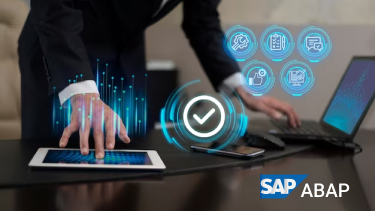Section 1: Introduction to ERP
o What is ERP?
o Why we need ERP?
o Advantages of ERP
o Major ERP Packages
Section 2: Introduction to SAP & R/3 Architecture
o What is SAP?
o History & Features of SAP
o SAP R/2 Architecture (Limitations of R/2 Architecture)
o SAP R/2 Architecture (Types of work processes)
o SAP R/3 Application Modules
o SAP Landscape
Section 3: Introduction to ABAP/4
o What is ABAP?
o Logon to SAP Environment
o Transaction Codes
o Multitasking Commands, Comments, Errors
o ABAP/4 Editor (SE38)
o Steps for Creating a Program
o Elements in R/3 Screen
o Output Statements
o Operators in ABAP
o Data
o Parameter & Constant Statements
o Data Types & Classification
o Data Objects & Classification
o Text Elements
o String Operations
o Control Statements
o Field Strings
Section 4: ABAP Dictionary
o ABAP Dictionary Introduction
o Data Dictionary Functions
o Data Dictionary Objects
o Data Base Tables, Structures, Views, Data Elements, Type Groups, Domain
o Search helps
o Lock objects
o Primary Key and Foreign Key
o Table Maintenance Generator
Section 5: Packages
o Creating a package
o Difference between local objects & packages
o Transferring local objects to packages
Section 6: Variants
o Variants Introduction
o Creating variants in ABAP Editor & Data Dictionary
Section 7: Message Classes
o Message Class Introduction
o Message types
o Calling message class in Report & Dialog Programs
o Selection Screens
o Selection Screen Introduction
o Parameter Statement
o Select-options Statement
o Selection-screen Statement
o Screen tables and its fields
o Dynamic screen modification by using Modif ID Key
Section 8: Open SQL Statements
o Select
o Insert
o Modify
o Update
o Delete
Section 9: Internal Tables
o Internal Tables Introduction
o Declaring Internal Table
o Populating Internal Table
o Processing Internal Table
o Initializing Internal Tables
o Inner Joins and for all Entries
o Control Break Statements
Section 10: Debugging Techniques
o Debugging Techniques Introduction
o Break-points (Static & Dynamic)
o Watch Point
o Dynamically changing internal tables contents
o Debugging Techniques Introduction
o Break-points (Static & Dynamic)
o Watch Point
o Dynamically changing internal tables contents
Section 11: Modularization Techniques
o Modularization Techniques Introduction, Includes, Subroutines
o Passing Parameters to Subroutines
o Passing Tables to Subroutines
o Function Groups & Function Modules
Section 12: Reports
o Reports Introduction
o Classical Reports
o Interactive Reports
o Techniques Used for Interactive Reports
o Hotspot, Hide, Get Cursor
Section 13: Dialog / Module Pool Programming / Transactions
o MPP Introduction
o Relationship between Screen
o Flow Logic and Program
o Flow Logic Events
o Process Before Output (PBO)
o Process After Input (PAI)
o Process on Value Request (POV)
o Process on Help Request (POH)
o Include Programs in MPP, Include TOP, Include I01, Include O01, Include F01
o Dynamic Screens
o Leave Screen
o Leave to Screen
o Call Screen
o Set Screen
o Processing of List from Transaction and Vice Versa
o Elements in Screen Layout, Table Controls, Step Loops, Tabstrip Control, Subscreens
Section 14: Batch Data Communication
o BDC Introduction
o Recording
o MDC Methods
o Call Transaction Method
o Session Method
o Handling Table Controls in BDC
o Legacy System Migration Workbench
o Different methods
o Flat file creation
o Uploading Data
o File Handling
o Application Server
o Presentation Server
Section 15: SAP Scripts
o SAP Scripts Introduction
o Components of SAP Scripts
o Layout Set
o Standard Text
o Out Put Program
o Modifying Standard SAP Script Layouts
o Including Logos
o SAP script Utilities – Upload/Download
Section 16: Smart Forms
o Smart Forms Introduction
o Graphics Management
o Style Maintenance
o Paragraph Formats
o Character Formats
o Writing print program and designing layouts
Section 17: ALV Reports
o ALV Reports Introduction
o ALV through Function Modules
o ALV Types
Section 18: Runtime Analysis & SQL Tracing Cross Applications
o Introduction to Distributed Environment
o Introduction to Cross Application
Section 19: RFC
o Introduction to RFC
o Creating an RFC Destination between 2 Systems
o Creating Remote Enabled Function Modules
o Creating a program using Remote Enabled Function
Section 20: Modules ALE
o ALE Basics
o Overview of Outbound & Inbound Process
o Configuration Steps
o Define Logical systems
o Assign client to logical system
o RFC Destination
o Customer distribution model
o Creating Ports
Section 21: Docs
o What is an Idoc?
o Types of Idoc
o Basic Idocs
o Extension Idocs
o Creating Idocs
o Message Types
o Assigning Idoc type to Message type
Section 22: EDI
o EDI Basics
o Difference between ALE & EDI
o Overview of Outbound & Inbound Process
o Configuration Steps
o Port Creation
o Partner Profile Creation
o BAPIs
o BAPI Overview
o Creation of BAPI
Section 23: Workflow
o What is workflow?
o Overview of workflow
o User Exits
o User Exits Overview
o Types of User Exits, Field Exit, Screen Exit, Function Exit, Menu Exit
Section 24: BADIs
o BADIs Overview
o Defining a BADI
o Implementing a BADI





